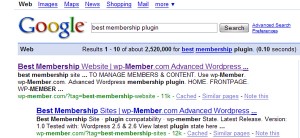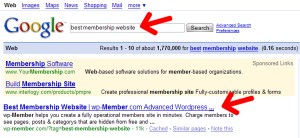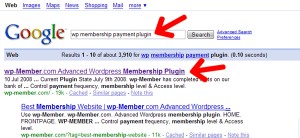plugin
WordPress Paypal Subscription

Using wp-Member you can sell access to parts, or all of your wordpress site. You can offer both free and paypal subscriptions. Create unlimited access levels and paypal subscriptions.
wp-Member will fully automate the user signup & privileges. wp-Member uses the Paypal Subscription Instant Payment Notification (IPN) to keep your users up to date.
Should a member miss a payment or cancel their wordpress paypal subscription the member is e-mailed telling them their payment is late. Then wp-Member downgrades the member to an inactive status.
Creating wordpress paypal subscriptions for membership sites has never been so easy. You can create your own wordpress paypal subscriptions in minutes with wp-member.
build membership site
Almost every website that provides information for users, will at some point need to create a membership system. By creating a membership site you can charge users a fee to access your extra content. wp-member is the best membership plugin and is designed to be flexable enough to meet the needs of almost every website owner.
wp-member is a plugin for the popular blogging system wordpress. By installing wp-member you can transform wordpress into a fully operational subscription based membership site. You can create as many access levels as you want. An access level is similar to a user group and will allow all users within it to only access the posts, pages and categories that you select. For each access level you can create as many subscriptions as you want ranging from 1 day to 99 years. All payments and subscriptions are managed using paypal IPN. Free and Trial accounts are also available and you can even set the length of the trial accounts you want to offer.
wp-member is the best membership plugin for you and your site. Search Google.com for “Best Membership Plugin” and you will see us right there at the very top. You can also view this by using this link.
We are the Best Membership Website with the Best Membership Plugin
Over the past few weeks we have been developing our website to make sure we can get the most users possible from search engines. We charge a low price for wp-member because we do not advertise wp-member anywhere. By completing a thorough SEO in house, we can target our site at millions of users while at the same time passing the discount onto our users. We do not see why a customer should pay extra because the company is unable to correctly target their site to naturally attract users.
Today, the 3rd of August 2008, the same day that we are launching our public licenses, we are number one on most of our prime keywords. Below I will show you a screenshot and a link to each search engine so that you can check for yourself.
Best Membership Plugin
Google.com (click here) #1 out of 2’520’000 results
Best Membership Website
Google.com (click here) #1 out of 1’770’000 results
Google.co.uk (click here) #1 out of 1’900’000 results
Google.co.in (click here) #1 out of 16’500’000 results
wp Membership Payment Plugin
Google.com (click here) #1 out of 3’910 results
Google.co.uk (click here) #1 out of 3’910 results
WordPress 2.6 Release – wp-Member Fully Tested
WordPress 2.6 has now been released. We had known about this since shortly after 2.5.1 was released and have been testing wp-Member all over again to ensure maximum compatibility with 2.6, although it is mainly cosmetic changes we still wanted to fully test the whole plugin all over again so that we were still happy with it’s performance prior to release.
This has slightly delayed the release of wp-Member, but we want it to be thoroughly tested and documented before we release it. We hope to be releasing test licenses within the next 7 days as we come to the end of our deep testing phase and prepare the plugin for general release.
Expected Test release: 7 days
Expected General release: 14 days
Google XML Sitemaps
Google XML Sitemaps is a fantastic plugin. It saves so much time when writing a blog and should be a perminant part of wordpress (in our opinion). I can not sing the praises of Arne Brachhold enough for this plugin.
How it works
Google XML Sitemaps simply collects a list of pages, posts, categories and tags depending on your settings and outputs a xml sitemap.
The problem this causes
Google XML Sitemaps simply looks at the content you are creating and assumes that it is a standard blog. When using wp-Member, the pages that require a subscription to access will be hidden from free users. Google XML Sitemaps will list your protected pages, posts and categories you create in the xml sitemap that it outputs. This means that when the search engines come to view your website using the sitemap, they find that the protected pages, posts and categories do not seem to exist. This is because the search engines look at your website as a free, non registered user would see your site.
We looked at posabilities of allowing search engines partial access to your protected content, but if we did this then the search engines would index your protected content and it would then be widely available to anyone who viewed the search engines cached pages of your site. Naturally this would create a gaping security hole on your blog, so we designed wp-Member to fully protect the content you want protected from free unregistered members.
Because Google XML Sitemaps lists the links to your protected content and the serach engines can not access it, it will generate an error on the search engine. The error will be something like “404 (Not found)”, “page not found” or “link broken”. This can vary depending on the tool and search engine you are using.
The work around
Login to your blog, click on settings, then click on XML-Sitemap. Scroll down to Advanced options, here you will see Exclude the following posts or pages. In here you will need to enter the page and post numbers you would like excluded from the sitemap. You can get the page and post numbers by clicking on manage and then selecting page or post. If you hover the mouse over the name of the page or post it will show a link like this “http://www.mydomain.com/wp-admin/post.php?action=edit&post=54”. The number for this post is 54. Simply gather together the protected page and post numbers and enter them into the exclude list separated by commas.
Although this process is not necessary, it makes your search engine pages cleaner and makes it easier to quickly spot genuine errors.




